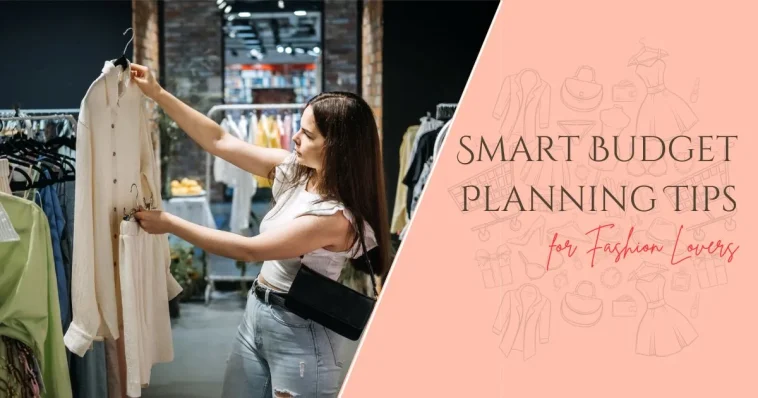If you love clothes, accessories, and the thrill of a great find, budgeting can feel like a mood killer. It does not have to be. With a bit of smart budget planning, a few rules you actually enjoy following, and innovative use of new resale and sustainable options, you can build a wardrobe that sings while your bank balance stays calm. This article walks you through a friendly, practical budget plan for fashion lovers in 2025, with real examples, brand picks, and money-saving tactics you can use right away.
Why Smart Budget Planning Matters In Fashion Right Now
The fashion industry is in a moment of slow but steady change. Macro reports say growth will be modest in 2025, which means brands and shoppers are more conscious about what they buy and why. Smarter spending now gives you better style without buyer regret later.
At the same time, secondhand, vintage, and smaller ethical labels are becoming more visible. Buying used or choosing brands that prioritize durability and transparency can stretch your budget and reduce the cycle of impulse purchases. Recent coverage highlights how vintage and curated, affordable, sustainable brands offer both style and value for people who want to look good and spend less over time.
Step 1 — Start With An Honest Wardrobe Audit
Before you plan a budget, know what you already own. A wardrobe audit takes 60 to 90 minutes. Pull everything out and sort into these piles:
- Keep: Items you wear at least once a month and love.
- Repair or tailor: Pieces that will come back into rotation with small fixes.
- Donate or sell: Good condition items you no longer wear.
- Toss: Stained, ripped, or unusable pieces.
Track what you keep by category: jeans, outerwear, shoes, work tops, casual tops, dresses, accessories. This lets you see gaps and avoid buying duplicates. Audits reduce wasted purchases, which is the fastest way to save.
Step 2 — Set A Realistic Annual Fashion Budget
Think in terms of an annual budget, not weekly impulses. A simple method is to allocate a percentage of your discretionary income to clothing. If you prefer a zero-based approach, decide the total you will spend in the next 12 months and divide it into four quarterly buckets. That keeps seasonal trends from wrecking your finances while giving you planned windows to shop.
Example budgets, adjusted by commitment:
- Minimalist commitment: $150 to $300 per year, focused on repairs and occasional quality buys.
- Balanced: $500 to $1,200 per year, mixes basics with two or three higher-quality pieces.
- Enthusiast: $1,500+ per year, includes trend pieces, consistent brand purchases, and occasional investment items.
Write the number down. Treat it like an upcoming subscription. If you overspend in one quarter, rebalance the rest of the year.
Step 3 — Define Categories And Priorities
Divide your budget into clear buckets so the money goes where it matters to you. Typical buckets include:
- Essentials: underwear, socks, core basics, one reliable coat.
- Work or uniform pieces: blazers, trousers, shoes.
- Trend or seasonal: the fun, shorter-lived items.
- Investment pieces: shoes, coats, bags that last years.
- Accessories and jewelry: lower cost but high style return.
- Resale and thrift fund: money set aside for secondhand scores.
Decide percentages. A practical split might be 40 percent essentials, 20 percent investment pieces, 20 percent trends, 10 percent accessories, and 10 percent resale or repairs. Adjust to taste.
Step 4 — Build A Capsule Approach With Flexibility
A capsule wardrobe centers on pieces that mix well, so you need fewer items overall. This is powerful for budgets. Start with neutrals and one or two accent colors, and pick items that layer and transition across seasons.
Brands that perform well for capsule foundations include Uniqlo for technical basics, Everlane for timeless tops and denim, and COS for more architectural silhouettes. For shoppers who want budget-friendly fashion that still reads modern, contemporary high street labels and new indie brands are worth watching. Recent roundups point to a mix of heritage and newer direct-to-consumer brands that combine quality and accessible price points.
Step 5 — The 30-30-40 Buying Rule
Here is a practical rule to guide purchases:
- 30 percent of purchases should be quality basics that last.
- 30 percent should be accessories or small items that refresh outfits.
- 40 percent can be trend or experimental pieces you do not intend to keep for years.
This rule keeps your closet balanced. If you are younger and trend-focused, flip the percentages; if you want longevity, give more to basics and investment items.
Step 6 — Choose Value Over Price Alone
Price alone is a poor judge of value. Consider the cost per wear. A $300 coat worn 150 times costs $2 per wear. A $30 trendy top worn five times costs $6 per wear. Focus on pieces that deliver the best value over time. Durable shoes, classic coats, and well-fitting trousers usually win the value game.
Sustainability lists and ethical brand guides from 2025 highlight labels that provide durability and repair options, which help reduce long-term spending. When you buy with repair in mind, your wardrobe becomes an asset rather than a drain.
Step 7 — Use Resale And Thrifting Strategically
Secondhand shopping is now mainstream and easy. Apps like Depop, Poshmark, Vinted, Mercari, and marketplaces that cross-list are great places to sell your items and buy others at lower prices. They make fashion collectible and circular while giving you funds for your next purchase. If you are comfortable with selling, you can recoup a lot of cost on seasonal buys. Guides to top resale apps in 2025 show that Depop and Vinted remain favorites among different age groups, and cross-listing tools help reach more buyers.
Tips for resale:
- Photograph items clean and wrinkle-free.
- Price with modest margins so items move.
- Reinvest proceeds into your capsule or an investment piece.
Step 8 — Hunt For The Right Deals, Not Just The Biggest Discounts
Timing matters. Seasonal sales, brand restocks, and outlet drops are useful, but the focus should be on value. Sign up for alerts from brands you love, follow small labels on social media, and set price alerts on resale sites. Sign up for student or first-time buyer discounts if eligible. Many publications curate under-$300 edits and ongoing affordable picks that are updated throughout the year, which helps spot truly worthwhile pieces.
Step 9 — Shop With A List And A Purpose
Impulse purchases are the budget killer. Before buying, ask:
- Do I have three outfits planned already for this item?
- Can this replace something I already own?
- Will I wear this at least 25 times?
If you cannot answer yes to at least one, consider waiting. Waiting does not mean forgetfulness. Instead, add the item to a wishlist and review it in a week. Frequently, the desire fades.
Step 10 — Prioritize Repairs And Tailoring
Small investments in tailoring and shoe repairs keep pieces wearable and elevate inexpensive items. Hemming, taking in a blazer, and sole replacement for shoes are low-cost ways to extend lifespan. Budget about 5 to 10 percent of your annual closet fund for repairs. Treating clothes as long-term investments lowers effective spend per wear.
Brands And Product Examples For 2025 Shoppers
Here are practical brand picks across budgets that have been frequently recommended in 2025 roundups and reviews.
Value basics and technical essentials:
- Uniqlo is known for quality knitwear and functional layers.
- Amazon Essentials and similar labels for affordable basics that pass everyday tests.
Mid-range, ethical, and transparent:
- Everlane is praised for its transparency and reliable denim and knitwear.
- Madewell and Reformation for pieces that balance trend and quality.
- COS for elevated minimalism in durable fabrics.
Sustainable and small-batch labels to watch:
- Smaller direct-to-consumer and indie labels that produce in small batches are highlighted in trend coverage, especially those emphasizing repairability and reduced waste. Recent features name several new high-street alternatives and community-driven brands that offer fresh design with an ethical focus.
Shoes and accessories with high returns:
- Allbirds and Veja for comfortable, sustainable sneakers.
- Mid-range jewelers such as Mejuri and Monica Vinader for quality everyday jewelry without the extreme price tag.
Secondhand first picks:
- Depop for vintage and unique streetwear.
- Vinted and Poshmark for mainstream wardrobe items at discounted rates. Cross-listing helps items sell faster.
Real-Life Example: How To Spend An $800 Annual Fashion Budget
Here is a sample allocation for someone who loves style but wants discipline:
- $240 (30 percent) on essentials: three quality tops from Everlane or Uniqlo and a pair of well-fitting jeans.
- $200 (25 percent) on one investment piece: a midweight coat or leather boots, perhaps from a brand like Madewell or a discounted sustainable label.
- $160 (20 percent) on trends: small dresses, a seasonal skirt, or a statement bag bought on sale or secondhand.
- $80 (10 percent) on accessories and jewelry: minimalist studs from a mid-range jeweler.
- $120 (15 percent) reserved for resale buying and repairs: a thrifted find, a pair of vintage boots, and some tailoring.
This approach keeps your look fresh while building long-term value.
Smart Tools And Tactics For 2025
- Use resale cross-listing tools to sell faster and maximize resale returns. They save time and increase visibility across platforms.
- Follow curated under-budget roundups from trusted fashion outlets to spot high-value items and avoid trend traps.
- Try a pre-commitment method. Put your intended purchase amount into a savings subaccount. If you still want the item after a week, spend from that account. This creates deliberate buying habits.
Final Rules Every Fashion Lover Can Live By
- Measure the cost per wear before buying major items.
- Sell what you do not wear and recycle the proceeds.
- Invest in footwear and outerwear first; they define many outfits.
- Learn basic mending and find a local tailor.
- Keep a wishlist and a cooling-off period to avoid impulse buys.
A Stylish Future That Fits Your Budget
Fashion is a lifelong joy, not a sprint. In 2025, the options are richer than ever, from circular resale marketplaces to affordable sustainable brands and high street edits that help you look current without overspending. The key is a plan that respects both your style and your finances. When you buy less and buy better, your wardrobe becomes a curated expression of taste, not an expense to regret.


